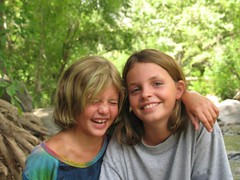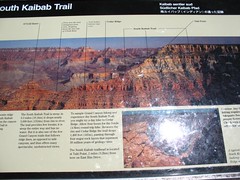“It's a deer,” my mother blurts out. She sounds excited. This encounter with wild life in a national park is a treat to be savored, a special part of the camping experience.
Aeron barely looks up to note calmly, “Mule deer.”
“What?” Mom glances over her shoulder. She stands posed at the edge of our camp site, straining to see better without taking the National Park Service forbidden step towards the ambling herbivore. She can barely contain herself, fingers itching to take a picture or touch the hide.
“Mule deer,” repeats my youngest, her head back in her coloring book. She explains without looking up again, “See the long ears and the markings on the coat?”
Mom checks the deer and sounds somewhat awed as she breathes, “Mule deer.” I'm not sure if it's the 8 year old naturalist or the two beautiful animals now striding slowly in our direction followed by a hyperventilating photographer from the Netherlands who clearly hasn't read the park rules.
Probably both. Aeron and Mera are now officially sworn Junior Park Rangers in nine national parks: Petrified Forest, Bandalier, Aztec Ruins, Navajo National Monument, Grand Canyon, Bryce Canyon, Zion, Devil's Post Pile, and Yosemite. They can recite chapter and verse regarding park protection and maintenance procedure, distinguish between a sparrow and a white breasted nut hatch, report on the history and cultural significance of the ancestral Pueblan peoples, and talk intelligently about the geological formation of the Colorado River Plateau. The one-two punch of a year on a cruising sailboat followed by a month in our nation's best and perhaps most important cultural export has producd accomplished amateur naturalists with a respectful but rather casual view towards wild life. It's fair to say that if there is a polar opposite to nature deficit disorder, my girls are the poster children.
I'm proud of Mera and Aeron for all their work on their ranger patches. We started the program initially as an alternative to doing school on the road. However, the accrual of badges, patches, and parks soon took on a life of its own. They now actively seek out the Junior Ranger programs in each park and complete the activities without fuss or argument. My mother promised to make them Ranger vests on which they can sew all their awards and stick all their buttons. Both girls have expressed an interest in becoming rangers themselves when they grow up. They could surely do worse as a career.
I highly recommend to all parents that you look into the educational programs available through our nation's parks and forests. Even when you can't visit a park, there are usually many learning opportunities online. My only suggestion to the folks at the National Park Service is that they develop a comparable curriculum for the high school age groups. Jaime was, unfortunately, somewhat left out of the fun this summer. And unlike her mother, she's too old to just roll with it and do the “little kid work” to young to not lose her dignity in coloring animal pairs.
“And what's that?” Grandma Sue asks pointing at the black shape flitting through the dusk darkened boughs of Zion's campground.
“Bat, of course,” Aeron informs my mother. “They see by echo-location and eat mosquitoes so you have to like them.”
Okay, Junior Ranger Aeron. We have to like them.
Aeron barely looks up to note calmly, “Mule deer.”
“What?” Mom glances over her shoulder. She stands posed at the edge of our camp site, straining to see better without taking the National Park Service forbidden step towards the ambling herbivore. She can barely contain herself, fingers itching to take a picture or touch the hide.
“Mule deer,” repeats my youngest, her head back in her coloring book. She explains without looking up again, “See the long ears and the markings on the coat?”
Mom checks the deer and sounds somewhat awed as she breathes, “Mule deer.” I'm not sure if it's the 8 year old naturalist or the two beautiful animals now striding slowly in our direction followed by a hyperventilating photographer from the Netherlands who clearly hasn't read the park rules.
Probably both. Aeron and Mera are now officially sworn Junior Park Rangers in nine national parks: Petrified Forest, Bandalier, Aztec Ruins, Navajo National Monument, Grand Canyon, Bryce Canyon, Zion, Devil's Post Pile, and Yosemite. They can recite chapter and verse regarding park protection and maintenance procedure, distinguish between a sparrow and a white breasted nut hatch, report on the history and cultural significance of the ancestral Pueblan peoples, and talk intelligently about the geological formation of the Colorado River Plateau. The one-two punch of a year on a cruising sailboat followed by a month in our nation's best and perhaps most important cultural export has producd accomplished amateur naturalists with a respectful but rather casual view towards wild life. It's fair to say that if there is a polar opposite to nature deficit disorder, my girls are the poster children.
I'm proud of Mera and Aeron for all their work on their ranger patches. We started the program initially as an alternative to doing school on the road. However, the accrual of badges, patches, and parks soon took on a life of its own. They now actively seek out the Junior Ranger programs in each park and complete the activities without fuss or argument. My mother promised to make them Ranger vests on which they can sew all their awards and stick all their buttons. Both girls have expressed an interest in becoming rangers themselves when they grow up. They could surely do worse as a career.
I highly recommend to all parents that you look into the educational programs available through our nation's parks and forests. Even when you can't visit a park, there are usually many learning opportunities online. My only suggestion to the folks at the National Park Service is that they develop a comparable curriculum for the high school age groups. Jaime was, unfortunately, somewhat left out of the fun this summer. And unlike her mother, she's too old to just roll with it and do the “little kid work” to young to not lose her dignity in coloring animal pairs.
“And what's that?” Grandma Sue asks pointing at the black shape flitting through the dusk darkened boughs of Zion's campground.
“Bat, of course,” Aeron informs my mother. “They see by echo-location and eat mosquitoes so you have to like them.”
Okay, Junior Ranger Aeron. We have to like them.

